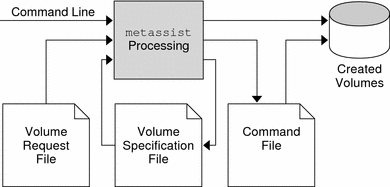Chapter 22 Top-Down Volume Creation (Overview)
This chapter provides conceptual information about Solaris Volume Manager top-down volume creation.
This chapter contains the following information:
For information about performing related tasks, see Chapter 23, Top-Down Volume Creation (Tasks).
Overview of Top-Down Volume Creation
Top-down volume creation enables you to automatically create Solaris Volume Manager volume configurations using the metassist command. You no longer need to manually go through the process of partitioning disks, creating RAID-0 volumes (as submirrors), creating hot spare pools and hot spares, and finally creating a mirror. Instead, you can issue the metassist command to create a volume. Solaris Volume Manager does the rest for you.
The metassist command enables you to create Solaris Volume Manager volume configurations with a single command. You can specify volume characteristics in terms of quality-of-service. Quality-of-service characteristics means that without specifying the hardware components to be used in a volume, you can use input to the metassist command to provide the following:
-
Volume size
-
Level of redundancy, which refers to the number of copies of the data
-
Number of data paths to the volume
-
Fault recovery, which indicates whether the volume is associated with a hot spare pool
You can specify the volume by quality-of-service with command-line options or in an input file named on the command line.
In some cases, it is important to more specifically define the volume characteristics or the constraints under which the volumes should be created. In such cases, you can also specify the following characteristics:
-
Volume types (for example, a RAID-0 (concatenation) or RAID-0 (stripe) volume).
-
Components to use in specific volumes.
-
Components that are available or unavailable for use.
-
Number of components to use.
-
Details specific to the type of volume being created. Details include the stripes, the read policy for mirrors, and similar characteristics.
If you prefer to specify the names, sizes, and components of a volume in more detail, use an input file. Input files include volume request files and volume specification files. For more information on how to use input files, see Top-Down Volume Creation Processes.
Finally, you can constrain the metassist command to use (or not use) specific disks or paths.
Top-Down Volume Creation Implementation With Disk Sets
The metassist command uses Solaris Volume Manager disk sets to manage volumes and available disks for top-down volume creation. For any given top-down volume creation process, all the disks used as building blocks must be either in the disk set or available to add to the disk set. You can use the top-down creation process to create volumes in different disk sets. However, the disks and components that are available are constrained by disk set functionality.
Top-Down Volume Creation Processes
The top-down volume creation process provides flexibility by offering the following processes:
-
A fully automated end-to-end process through which you can specify needed constraints and have the necessary volumes created when the command completes
-
A more granular process with breakpoints at which you can write to an XML-based file
The following figure shows how the metassist command supports end-to-end processing based on command-line input and input files. The figure also shows how the metassist command supports partial processing, which allows you to provide file-based data or to check volume characteristics.
Figure 22–1 Processing Options for Top-Down Volume Creation

For an automatic, hands-off approach to volume creation, use the command line to specify the quality-of-service characteristics you require. The metassist command automatically creates the requested volumes for you. For example:
# metassist create -s storagepool -S 10Gb |
This command creates a stripe volume of 10 Gbytes in size in the storagepool disk set. The command uses available storage that exists in the storagepool disk set.
Alternatively, you can use a volume request file to define the characteristics of a volume. Then, you can use the metassist -F request-file command to create a volume with those characteristics.
You can use the metassist -d command to produce a volume specification file. You can use this file to assess the intended implementation and edit the file, if needed. The volume specification file can then be used as input to the metassist command to create volumes.
Finally, you can use the metassist -c command to create a command file. The command file is a shell script that implements the Solaris Volume Manager device configuration specified by the metassist command. You can use this file for repeated volume creation and edit the file, as appropriate.
When you use the metassist command to create these files, you learn what the metassist command does and how it makes decisions. This information can be useful for troubleshooting some of the following:
-
Why a volume was created in a certain way
-
Why a volume was not created
-
What volumes the metassist command would create, without actually creating the volumes
Determining Which Disks Are Available for Top-Down Volume Creation
The metassist command checks disks to determine which disks appear to be unused. The command attempts to conservatively determine which disks are available. Any disk or slice that is in use is unavailable for use by the metassist command. The metassist command checks the following:
-
Disks used in other disk sets
-
Mounted slices
-
Slices with a file system superblock, indicating a mountable file system
-
Slices used in other Solaris Volume Manager volumes
Any slices that meet one of these criteria are unavailable for top-down volume creation.
- © 2010, Oracle Corporation and/or its affiliates
